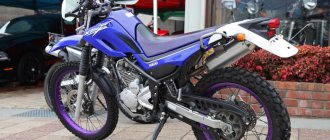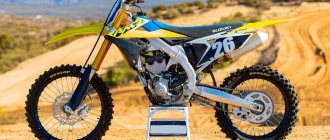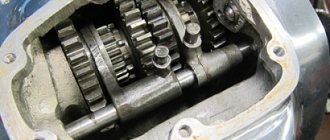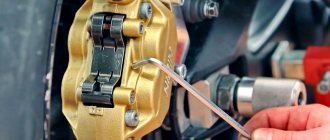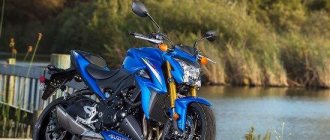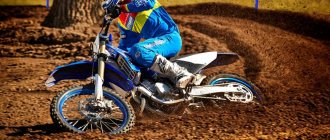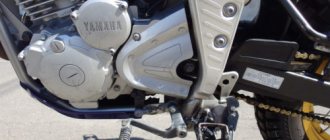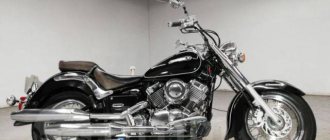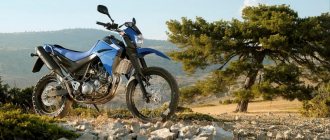Cheap doesn't always mean bad. Especially if we are talking about the Yamaha Serow 225 bike. Having debuted in 1987, it became the ideal solution for people who love enduro , but at the same time live and work in the “ asphalt jungle ”. The model lived on the assembly line for 15 years, and at the beginning of the new century it was considered obsolete and production was closed.
The budget price made it possible to buy it as an addition, a second or even a third bike. But good suspension, engine protection, and low fuel consumption made it possible to use the motorcycle as the main everyday means of transportation.
Bike features
Here are the main advantages of the model:
- excellent adaptability to driving on mountain slopes;
- significant traction;
- comfortable but low rise;
- minimalism in everything.
The last point, by the way, may confuse some at first, since that is why the motorcycle looks somewhat tasteless. It’s just that the designers prioritized practicality rather than aesthetics. If you remember this, no questions will arise for the bike.
Driving performance
Has anyone tried to set the needle to more than 120 km/h in winter?
The speedometer markings correspond to the passport specifications - a little more than 120. Users were able to accelerate so that the needle lay down - approximately 135 km/h .
There was still a small reserve of power left - the lack of wind protection and unbalanced aerodynamics hampered it. Later, the developers noted that the violation of aerodynamics is not a mistake, but a distinctive feature. Why such speeds on enduro?
Fuel consumption
Fuel consumption during normal driving around the city was 3-3.5 liters. When driving on country roads it rarely rose above 2.
The final results depended on the quality of the canvas.
Acceleration to hundreds
9 seconds to hundreds is a good indicator for this class of motorcycle.
Acceleration to 100 was 9 seconds - a standard speed for the line. The same results were shown by bikes assembled on this basis.
Dimensions and weight
Without fuel, the XT 225 Serow weighs 108 kg, which is very light even for a small off-road motorcycle. A tank volume of 9.8 liters is quite sufficient, since the average gasoline consumption per hundred kilometers for this model is approximately 3 liters. The motorcycle's seat height is 810 mm, its length is 2070 mm, its width is 805 mm, and its overall height is 1161 mm.
Flaws
Apart from a trick in the form of a deliberate violation of aerodynamics, the model did not have any major shortcomings.
- Some users noted a discrepancy between the starting currents of the battery and the starter . For trips in winter, a fully charged battery was needed, but it was difficult to attribute this to non-delivery - all batteries suffer from this.
- Tall motorcyclists noted that despite the height, the footrests needed to be lower . “My knees get high, my legs are uncomfortable and they get tired quickly, I can’t even dream of a day in the saddle like on other enduros.”
Chassis and brakes
The frame of this model is made of steel. It may seem dull to some, but there is simply nothing superfluous about it. The rims are medium in size and spoked in type. The handlebars are typical for an off-road bike and allow you to control it comfortably even on bumpy, rough terrain.
The rear suspension is a pendulum version along with a monoshock absorber. At the front, a telescopic fork serves as this. The rear brake is a 220mm disc assisted by a single-piston caliper. At the front, the XT 225 Serow brakes using a disc of the same diameter, but there is a two-piston caliper.
Modifications
Since at the time of production the model did not have any special competitors in terms of price/quality, they did not engage in any modifications for it.
The Yamaha TW 225 was produced for the domestic market, looked stylish, and was successful even outside of Japan.
But the concept of the model served as a prototype for several other developments of the brand:
- TW 225 . In 2002 it took over from serow. Intended for domestic sales. Thanks to consumer interest, it appeared in markets outside Japan.
- ST 225 Bronco is a scrambler. Enduro is closer to the realities of city riding. It was produced for 2 years, starting in 1997. It had a redesigned gearbox for more convenient trips around the city.
- XT 225 . Under this name the basic model was offered for the US markets. Apart from the name and external color (more cremated), there were no differences.
In 2005, Serow received a second life. With minor modifications, a model with a 250 cc engine - Serow 250 - is put on the conveyor.
Engine
The Yamaha XT 250 is powered by a single-cylinder, four-stroke engine with a displacement of 249 cubic centimeters, a peak power of 21 horsepower and a maximum torque of 20.5 Nm. The chassis, like the power unit, is almost completely borrowed from the previous generation - Serow 225 - and is represented by a front telescopic fork and a rear adjustable monoshock absorber. The most serious changes made to the technical component of the motorcycle were the introduction of an electric starter and the elimination of the kick starter. Since 2007, it began to be equipped with an injection power system, which replaced the carburetor.
Review of the Yamaha Serow 225 (XT 225) motorcycle
So, Yamaha Serow 225, a domestic Japanese model, released in the late 80s and stood on the assembly line for 20 years. This model is cheaper than the TTR and its classmates, so I paid attention to it when looking for a motorcycle. In addition, I was attracted by the height of the saddle, because... Our terrain is hilly and sometimes mountainous. I have never regretted my choice.
I think that this is an ideal motorcycle for learning the basics of driving, even better than the vaunted YBR 125. With similar weight and saddle height, it has some kind of engine (it was enough for me), it handles excellently (I rode the YBR, though not for long). and on someone else’s - I didn’t like it), plus it allows you to calmly ride away from the asphalt, which cannot but affect the safety of this activity (I know that YBRs are also like enduring :) ).
I really liked the Motorreview reviews (as many as 2 articles!), which say that the moto is greatly underrated in Russia, but in fact is not much inferior to the TTR-XR-DR trio. I can say that we met quite a lot of people at KMV who rode this model and responded extremely positively.
I have only 2 complaints about the motorcycle:
1) Doesn't start well when cold. I read about this on forums, talked with an experienced sulfur specialist, they say that the problem is not curable. Specifically with my motorcycle, I found out that starting success depends on the battery charge. If it is charged perfectly, it will start on the first try. If not, then it may not start at all. “Not ideal” I don’t mean that the starter barely turns, but that my charger shows that the battery is 3/4 charged. A couple of times the battery from the BM 200 came to my rescue: it is larger in size, maybe it has a higher starting current, I don’t know, but the starter spun very quickly.
2) Small distance from the saddle to the footpegs. Compared to the same BM, the enduro is 10 cm smaller. Because of this, the landing is not very comfortable, the knees are raised and the legs get tired quickly. My height is 178 cm. Driving while standing did not cause any problems, so I did not sit down unnecessarily. Actually, that’s why the motorcycle was sold; I never got used to the landing. On the other hand, I’ve seen people who are taller than me and ride calmly, without bothering with seat tuning or anything like that.
They also say that the rear shock absorber is too weak for heavy riders; I had no problems with a weight of 75 without equipment (I don’t know how much it weighs, probably 5-6 kilograms).
I hope my post will be useful to someone when choosing the first motorcycle in their life. Finally, I want to say that I sold it for quite a long time, I suspect that, again, due to the undervaluation or unknown of this model.
I had a Serov from 1991, I didn’t see anything good, in the mountains at full throttle on twists and turns, KTM workers smoked on the stone steps, in such conditions the piston engine lived for about 60 thousand km. Moreover, Serov was run over by a freight train - he was dragged along the rails 50 meters, they couldn’t get through, they burned the clutch in the mud, they put wires in the disks to get to the house, the current on the rails from behind the bushes, a serun, came out and then a freight car, well there weren’t many cars... In general, in the end they changed the clutch and steering wheel and ajaaaaa...Then I got married, I needed money, I sold it from Serun, my documents and the two of me and my wife had no dock in the mountains and only at about 80 thousand km the traction disappeared and the engine began to consume oil.. As a result, it turned out that the membrane on the carb broke through. I didn’t have any motorcycles, but Serov has never met one more reliable than a Yamaha.
A couple of lines about my Serov. I bought it for 75, drove it for 2 years, and sold it for the same money. This is my first moto, I hesitated for a long time between the new ebr and the old enduro. The device served faithfully, rode almost all summer both around the city and at the dacha in the forest, in wet weather, when soaked clay sticks to the wheels, if you fall, you can lift the moto yourself without outside help (I can’t say that I’m weak, but I can lift the jebel 250 much more difficult).
The front sprocket fits from the eaves, if you want other sprockets, order on foreign sites, it turns out to be more than 2 times cheaper. You can drive around the city, but it’s not very comfortable, the steering wheel is too wide, it caught car mirrors twice, the speakers are too much. On the highway, Serov openly drains the rest of the checks, 100-110 is the maximum, at high speeds the engine begins to snot. But there is one BUT, when overtaking trucks, unlike ebr, you don’t have to be afraid that the air currents will slow you down. You can overtake with confidence.
In winter I rode a connecting rod bear, a blatant mockery of myself and my equipment. Serov walked most of the route and took me back to the camp. I respect the reliability of Yamaha. For beginners, I advise you to read the rules for starting the engine after falling on the left/right side, it will come in handy. (get used to taking care of the battery, there is no kick!!!) When choosing, I advise you to buy a compression meter (250 rubles) and measure the compression, on 3 of the 7 motors I looked at it was less than 6, but the engine started up confidently.
After 2 years, I decided that I travel more in the city and a scooter would be more suitable for me. Xers, bajas and jebels are worth the money, but consider whether you can use them to 100% of their potential. Finally, I’ll say that I’m 1.89 tall, it’s okay to ride alone, it’s inconvenient for two, but you can get there.
Yamaha XT250X 2006
| Make Model | Yamaha XT 250X |
| Year | 2006 |
| Engine | Air cooled, four stroke, single cylinder. SOHC. |
| Capacity | 249 |
| Bore x Stroke | 74.0 x 58.0mm |
| Compression Ratio | 9.5;1 |
| Induction | 33mm Vac |
| Ignition/ Starting | CDI/electric |
| Max Power | |
| Max Torque | |
| Transmission/Drive | 5 Speed/chain |
| Front Suspension | 35mm telescopic fork, |
| Rear Suspension | Swingarm w/rebound-adjustable single shock. |
| Front Brakes | Single disc |
| Rear Brakes | Single disc |
| Front Tire | |
| Rear Tire | |
| Dry-Weight | |
| Fuel Capacity |
Brief history of the model
1985 - start of production and sales. First generation. Model: Yamaha XT225W Serow (Japan). Factory designation: 1KH.
1986 - no significant changes. Model: Yamaha XT225W Serow (Japan). Factory designation: 1RF0.
1987 - no significant changes. Model: Yamaha XT225W Serow (Japan). Factory designation: 2LN0.
1989 - restyling of the model. Second generation. Model: Yamaha XT225W Serow (Japan). Factory designation: 3RW1.
1991 - no significant changes. Model: Yamaha XT225W Serow (Japan). Factory designation: 3RW2.
1992 - no significant changes. The model becomes available in foreign markets. Model: Yamaha XT225W Serow; Yamaha XT225D (Japan; Europe, North America). Factory designation: 3RW3, 3RW4; 4BE3.
1993 - restyling of the domestic Japanese model. Third generation. Model: Yamaha XT225W Serow; Yamaha XT225E (Japan; Europe, North America). Factory designation: 3RW5, 4JG1; 4BE6.
1994 - no significant changes. Model: Yamaha XT225F (Europe, North America). Factory designation: 4BE9.
1995 - no significant changes. Model: Yamaha XT225W Serow; Yamaha XT225G (Japan; Europe, North America). Factory designation: 4JG2, 4JG3; 4BEC.
1996 - no significant changes. Model: Yamaha XT225W Serow; Yamaha XT225H (Japan; Europe, North America). Factory designation: 4JG4; 4BEF.
1997 - restyling of the domestic Japanese version. Fourth generation. Model: Yamaha XT225WE Serow; Yamaha XT225J (Japan; Europe, North America). Factory designation: 4JG5; 4BEJ.
1998 - no significant changes. Model: Yamaha XT225WE Serow; Yamaha XT225K (Japan; Europe, North America). Factory designation: 4JG6; 4BEM.
1999 - no significant changes. Model: Yamaha XT225L (Europe, North America). Factory designation: 4BER.
2000 - restyling of the domestic Japanese version. Fifth generation. Model: Yamaha XT225WE Serow; Yamaha XT225M (Japan; Europe, North America). Factory designation: 5MP1; 4BEU.
2001 - no significant changes. Model: Yamaha XT225N (Europe, North America). Factory designation: 4BEW (California), 4BEV (USA), 4BEX (Europe).
2002 - no significant changes. Model: Yamaha XT225WE Serow; Yamaha XT225P (Japan; Europe, North America). Factory designation: 5MP2; 4BEY (USA), 5RK1 (California), 5RK2 (Europe).
2003 - no significant changes. Model: Yamaha XT225WE Serow; Yamaha XT225R (Japan; Europe, North America). Factory designation: 5MP3; 5RK3 (USA), 5RK4 (California), 5RK5 (Europe).
2004 is the last year of production of the domestic Japanese version. Model: Yamaha XT225WE Serow; Yamaha XT225S (Japan; Europe, North America). Factory designation: 5MP4; 5RK6 (USA), 5RK7 (California), 5RK8 (Europe).
2005 - no significant changes. Model: Yamaha XT225T (Europe, North America). Factory designation: 5RK9 (USA), 5RKA (California), 5RKB (Europe).
2006 - no significant changes. Model: Yamaha XT225V (Europe, North America). Factory designation: 5RKC (USA), 5RKD (California), 5RKE (Europe).
2007 is the last year of production of export versions. Model: Yamaha XT225W (Europe, North America). Factory designation: 5RKF (USA), 5RKG (California), 5RKH (Europe).
